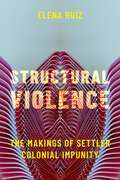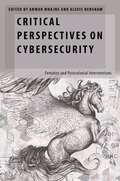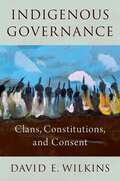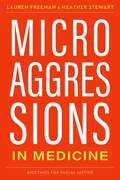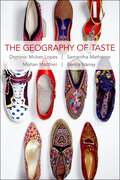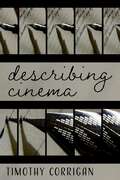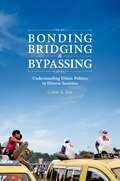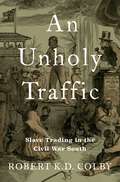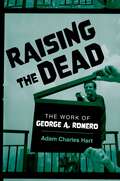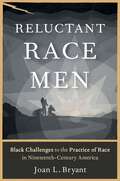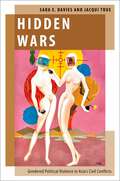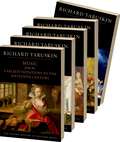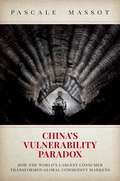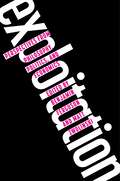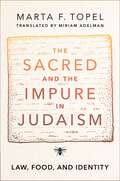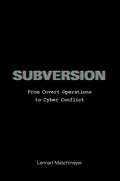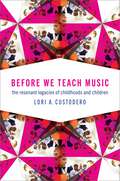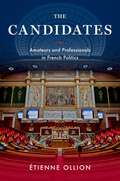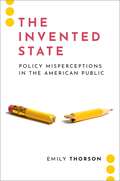- Table View
- List View
Structural Violence: The Makings of Settler Colonial Impunity
by Elena Ru?zEnduring social inequalities in settler colonial societies are not an accident. They are produced and maintained by the self-repairing structural features and dynastic character of systemic racism and its intersecting oppressions. Using methods from diverse anticolonial liberation movements and systems theory, Structural Violence theorizes the existence of adaptive and self-replicating historical formations that underwrite cultures of violence in settler colonial societies. Corresponding epistemic forces tied to profit and wealth accumulation for beneficiary groups often go untracked. The account offered here argues that these epistemic forces play a central role in producing and maintaining massive health inequalities and the maldistribution of disease burdens?including those associated with sexual violence?for marginalized populations. It upends the widespread view that structural racism can be dismantled without addressing gendered violence. It also advocates for a theory of change rooted in reparative action and models of structural competency that respond to the built-in design of structural violence and the ecosystems of impunity that allow it to thrive.
Critical Perspectives on Cybersecurity: Feminist and Postcolonial Interventions (Oxford Studies in Gender and International Relations)
by Anwar Mhajne and Alexis HenshawTraditional notions of national security have generally dominated cybersecurity debates, but the response to emerging cybersecurity issues should not merely focus on the militarization of cyberspace. Weaponizing a space heavily populated by civilians has enormous implications for human rights. Yet, cybersecurity studies in international relations have largely overlooked the impact of cybersecurity policies on individuals and communities--including the consequences of surveillance, data overcollection, cybercrime, and cyberbullying. Critical Perspectives on Cybersecurity offers a new approach to understanding cybersecurity in international relations. As a counterpoint to existing work, which focuses largely on the security of states, private actors, and infrastructure, chapter authors examine how women and communities across the Global South understand "cybersecurity," including what threats and forms of resistance are most important to them. They make the case that policies need to consider individual human rights by putting people's empowerment and wellbeing at their center. Drawing on feminist and postcolonial theory, the chapters also cover issues that challenge conventional notions of cybersecurity, including disinformation, gender-based violence online, and technology as a neocolonial force. Bringing together contributions from a globally diverse range of authors, Anwar Mhajne and Alexis Henshaw provide a human security perspective on cybersecurity that pays attention to the interplay of race, ethnicity, gender, class, and other social hierarchies, especially regarding cybersecurity in the Global South.
Indigenous Governance: Clans, Constitutions, and Consent
by David E. WilkinsAfter decades of federal dominance and dependence, Native governments now command attention as they exercise greater degrees of political, economic, and cultural power. Given the weight and importance of many issues confronting Native peoples today, these governments arguably matter even more to their peoples and to the broader society than ever before. Native governments have become critically important as the chief providers of basic services and the authors of solutions to collective problems in their societies. As major actors within the realm of democratic politics, they increasingly wield their powers to educate and advocate regarding Indigenous concerns. For many communities (including non-Native neighbors) they are the largest spenders and employers. They have also become adept at negotiating intergovernmental agreements that protect their peoples and resources while strengthening their unique political status. Native peoples and governments are also navigating the devastating and lingering health and economic impact of COVID-19; the profound environmental problems that have been exacerbated by climate change; and jurisdictional conflicts with local, state, and federal actors. Indigenous Governance is a comprehensive, critical examination of Native political systems: the senior political sovereigns on the North American continent in terms of their origin, development, structures, and operation. Author David E. Wilkins provides the recognition and respect due Indigenous governments, while offering a considered critique of their shortcomings as imperfect, sovereign institutions. This appraisal will highlight their history, evolution, internal and intergovernmental issues, and diverse structures.
Microaggressions in Medicine (Bioethics for Social Justice)
by Lauren Freeman Heather StewartIn a world that too often marginalizes people based on their race, gender, sexual orientation, body size, or disability, medicine can often be no different. Far from ?doing no harm,? it treats some patients unfairly, leading to detrimental effects. Guided by diverse patient testimonies and case studies, Microaggressions in Medicine focuses on the harms that such patients face. It amplifies their voices, stories, and experiences, which have too-often been excluded from mainstream bioethical, medical, and popular discussions. Microaggressions in medicine are not rare, but frequent in the healthcare experiences of marginalized patients. Recognizing this can help patients better understand and make sense of their experiences. As bioethicists Lauren Freeman and Heather Stewart argue, building such an awareness can also help current and future healthcare professionals recognize the serious and enduring consequences that microaggressions have on their patients. Freeman and Stewart offer practical strategies for healthcare professionals to reduce microaggressions in their practices. The harms of microaggressions are anything but micro. Healthcare professionals have a moral obligation to prevent them as much as possible. Health equity can be achieved, but only through first recognizing the harm caused by microaggressions in medical contexts. Shining a light on microaggressions in medicine and offering concrete ways for health professionals to avoid them in the future will make a positive difference in the lives of marginalized patients as they interact with medical institutions and practitioners. All patients deserve high quality, patient-centered care but healthcare professionals must change their practices in order to achieve such equity.
The Geography of Taste (Thinking Art)
by Bence Nanay Dominic McIver Lopes Samantha Matherne Mohan MatthenThis is an open access title available under the terms of a CC BY-NC-ND 4.0 license. It is free to read at Oxford Academic and offered as a free PDF download from OUP and selected open access locations. Wherever on the globe anyone sets foot, they find people immersed in matters aesthetic. In UNESCO's definition, there can be no culture that lacks an aesthetic life. Aesthetic life is in this sense a cultural universal. At the same time, aesthetic engagement has a geography. While all cultures have an aesthetic, no single aesthetic belongs to all cultures. The rules of aesthetic engagement vary by culture. How should aesthetics proceed if we take this fact of aesthetic diversity, rather than the presumption of aesthetic universality as our starting point? How should we theorize the cultural origins and cultural basis of aesthetic diversity? How should we think about the value and normativity of aesthetic diversity? To model what the turn toward diversity might look like in aesthetic inquiry, the four authors of this book each defend a different account of aesthetic diversity, and together they engage in a collective dialogue about these issues. The Geography of Taste will interest students in aesthetics courses as well as others interested in novel, global approaches to aesthetics.
Describing Cinema
by Timothy CorriganIn Describing Cinema, award-winning film scholar Timothy Corrigan explores the art and poetics of writing about film. Part theory, part rhetoric, and part pedagogy, the text examines and demonstrates acts of describing scenes, shots, and sequences in films as the most common and most underestimated way viewers respond to movies. Describing Cinema represents a global range of movies from Hollywood to Morocco to Rome, made from the 1940s to the present. As Corrigan shows, energetic and careful descriptions can serve as exceptionally rich ways to demonstrate and celebrate the activities, varieties, and challenges of a central generative movement in the viewing and interpretation of films. At its best, the act of describing films never simply denotes actions, images, sounds, or styles but rather produces the orchestration of one or more of those dimensions as an often creative and intersubjective movement between images, viewers, and a rhetorical language. Providing an invaluable exploration of the challenges and rewards film scholars face in describing movies, Corrigan insists that writing about film becomes thinking about film.
Quantum Drama: From the Bohr-Einstein Debate to the Riddle of Entanglement
by Dr Jim Baggott Prof John L. HeilbronThe definitive account of the great Bohr-Einstein debate and its continuing legacy In 1927, Niels Bohr and Albert Einstein began a debate about the interpretation and meaning of the new quantum theory. This would become one of the most famous debates in the history of science. At stake were an understanding of the purpose, and defense of the integrity, of science. What (if any) limits should we place on our expectations for what science can tell us about physical reality? Our protagonists slowly disappeared from the vanguard of physics, as its centre of gravity shifted from a war-ravaged Continental Europe to a bold, pragmatic, post-war America. What Einstein and Bohr had considered to be matters of the utmost importance were now set aside. Their debate was regarded either as settled in Bohr's favour or as superfluous to real physics. But the debate was not resolved. The problems of interpretation and meaning persisted, at least in the minds of a few stubborn physicists, such as David Bohm and John Bell, who refused to stop asking awkward questions. The Bohr-Einstein debate was rejoined, now with a new set of protagonists, on a small scale at first. Through their efforts, the debate was revealed to be about physics after all. Their questions did indeed have answers that could be found in a laboratory. As quantum entanglement became a real physical phenomenon, whole new disciplines were established, such as quantum computing, teleportation, and cryptography. The efforts of the experimentalists were rewarded with shares in the 2022 Nobel prize in physics. As Quantum Drama reveals, science owes a large debt to those who kept the discussions going against the apathy and indifference of most physicists before definitive experimental inquiries became possible. Although experiment moved the Bohr-Einstein debate to a new level and drew many into foundational research, it has by no means removed or resolved the fundamental question. There will be no Nobel prize for an answer. That will not shut off discussion. Our Drama will continue beyond our telling of it and is unlikely to reach its final scene before science ceases or the world ends.
Bonding, Bridging, & Bypassing: Understanding Ethnic Politics in Diverse Societies
by Colm A. FoxSocietal divisions and even violence can occur when electoral candidates appeal to race, religion, or tribe. Why do candidates make these ethnic appeals? More specifically, why do some candidates appeal to their own ethnic group while others reach out to other ethnic groups or abandon ethnic appeals altogether? To answer this question, Colm A. Fox adopted a ground-breaking, novel approach to study campaign appeals made by thousands of candidates. He collected and systematically analyzed photographs of over 25,000 election posters from campaigns across Indonesia, along with newspaper reports and interview data. The book shows how electoral rules, political party ideology, ethnic demographics, and social norms shape candidates? decisions to bond with co-ethnics, bridge across other ethnic groups, or bypass ethnicity entirely. Its findings yield not only insights as to which ethnic identities are likely to become politicized, but also prescriptions on how to curb divisive ethnic politics.
An Unholy Traffic: Slave Trading in the Civil War South
by Robert K.D. ColbyThe Confederate States of America was born in defense of slavery and, after a four-year struggle to become an independent slaveholding republic, died as emancipation dawned. Between Fort Sumter to Appomattox, Confederates bought and sold thousands African American men, women, and children. These transactions in humanity made the internal slave trade a cornerstone of Confederate society, a bulwark of the Rebel economy, and a central part of the experience of the Civil War for all inhabiting the American South. As An Unholy Traffic shows, slave trading helped Southerners survive and fight the Civil War, as well as to build the future for which they fought. They mitigated the crises the war spawned by buying and selling enslaved people, using this commerce to navigate food shortages, unsettled gender roles, the demands of military service, and other hardships on the homefront. Some Rebels speculated wildly in human property, investing in slaves to ward off inflation and to buy shares in the slaveholding nation they hoped to create. Others traded people to counter the advance of emancipation. Given its centrality to their nationhood, Confederates went to great lengths to prolong the slave trade, which, in turn, supported the Confederacy. For those held in slavery, the surviving slave trade dramatically shaped their pursuit of freedom, inserting a retrograde movement into some people's journeys toward liberty while inspiring others to make the risky decision to escape. Offering an original perspective on the intersections of slavery, capitalism, the Civil War, and emancipation, Robert K.D. Colby illuminates the place of the peculiar institution within the Confederate mind, the ways in which it underpinned the CSA's war effort, and its impact on those attempting to seize their freedom.
Raising the Dead: The Work of George A. Romero
by Adam Charles HartGeorge A. Romero never intended to become a master of horror, but Night of the Living Dead made him a legend of the genre. Raising the Dead dives into the expansive, extraordinary body of work found in Romero's archive, going beyond his iconic zombie movies into a deep and varied collection of writings that never made it to the big screen. From the early 1960s until his death in 2017, Romero was a hugely prolific writer, producing scripts in every conceivable genre, from arty medieval allegories to wacky comedies to grand-scale science fiction epics. Though he had difficulty funding non-horror projects, he continued to write in whatever mode his imagination dictated, and he rarely abandoned his ideas. Themes, story ideas, and even characters were re-purposed for new scripts, evolving and transforming with each new iteration and, sometimes, finding a home in a horror film. But in order to accommodate ideas that began in such different contexts, Romero would have to change the horror genre itself: a zombie movie could become a savage satire of consumerism or an excoriating critique of militaristic or capitalist hierarchies. The horror genre became what Romero made of it. Based on years of archival research, the book moves between unfilmed scripts and familiar classics, showing the remarkable scope and range of Romero's interests and the full extent of his genius. Raising the Dead is a testament to an extraordinarily productive and inventive artist who never let the restrictions of the film industry limit his imagination.
Reluctant Race Men: Black Challenges to the Practice of Race in Nineteenth-Century America
by Joan L. BryantActivists in the earliest Black antebellum reform endeavors contested and deprecated the concept of race. Attacks on the logic and ethics of dividing, grouping, and ranking humans into races became commonplace facets of activism in anti-colonization and emigration campaigns, suffrage and civil rights initiatives, moral reform projects, abolitionist struggles, independent church development, and confrontations with scientific thought on human origins. Denunciations persisted even as later generations of reformers felt compelled by theories of progress and American custom to promote race as a basis of a Black collective consciousness. Reluctant Race Men traces a history of the disparate challenges Black American reformers lodged against race across the long nineteenth century. It factors their opposition into the nation's history of race and reconstructs a reform tradition largely ignored in accounts of Black activism. Black-controlled newspapers, societies, churches, and conventions provided the principal loci and resources for questioning race. In these contexts, people of African descent generated a lexicon for refuting race, debated its logic, and, ultimately, reinterpreted it. Reformers' challenges call into question the notion that race is a self-evident site of identity among Black people. Their ideas instead spotlight legal, political, religious, social, and scientific practices that configured human difference, sameness, hierarchy, and consciousness. They show how a diverse set of actions constituted multi-faceted American phenomena dubbed "race."
Hidden Wars: Gendered Political Violence in Asia's Civil Conflicts (Oxford Studies in Gender and International Relations)
by Jacqui True Sara E. DaviesSexual and gender-based violence (SGBV) has always been a part of warfare. In Asia, testimonies of egregious rape and sexual violence extend back to the Rape of Nanjing, to the experience of the Korean comfort women in World War II, and to forced marriages and sexual slavery during the Cambodian genocide. The past two decades have yielded crucial new insights about SGBV, but scholars and researchers still struggle to explain why and when this violence occurs. A major problem is that incidences of SGBV are vastly underreported; reliable data is especially scarce in Asia, where demographic and health surveys are infrequent and national reporting systems are underdeveloped relative to other parts of the globe. Asia also has some of the most protracted conflicts in the world but the complexity of subnational conflicts in Asia often masks the gendered dimensions of violence. In Hidden Wars, Sara E. Davies and Jacqui True examine the relationship between reports of SGBV and structural gender inequality in three conflict-affected societies in Asia--Burma, the Philippines, and Sri Lanka. Based on extensive field research and an original dataset on conflict-related SGBV, Davies and True show how reporting is significantly constrained by a variety of factors, including normalized gendered violence as well as political dynamics affecting local civil society, humanitarian, and international organizations. They address the real-world limitations of data collection and argue that these constraints reinforce a culture of silence and impunity that perpetuates SGBV and permits governments to abrogate their responsibility for this violence. Hidden Wars breaks new methodological ground in showing that what we know about SGBV can be understood fully only if the politicized context of reporting SGBV and data collection is taken into consideration.
Oxford History of Western Music: 5-vol. set
by Richard TaruskinThe Oxford History of Western Music is a magisterial survey of the traditions of Western music by one of the most prominent and provocative musicologists of our time. This text illuminates, through a representative sampling of masterworks, those themes, styles, and currents that give shape and direction to each musical age. Taking a critical perspective, this text sets the details of music, the chronological sweep of figures, works, and musical ideas, within the larger context of world affairs and cultural history. Written by an authoritative, opinionated, and controversial figure in musicology, The Oxford History of Western Music provides a critical aesthetic position with respect to individual works, a context in which each composition may be evaluated and remembered. Taruskin combines an emphasis on structure and form with a discussion of relevant theoretical concepts in each age, to illustrate how the music itself works, and how contemporaries heard and understood it. It also describes how the c
China's Vulnerability Paradox: How the World's Largest Consumer Transformed Global Commodity Markets
by Pascale MassotChina's Vulnerability Paradox explains the uneven transformations in global commodity markets resulting from China's contemporary, dramatic economic growth. At times, China displays vulnerabilities towards global commodity markets because of unequal positions of market power. Why is it that Chinese stakeholders are often unable to shape markets in their preferred direction? Why have some markets undergone fundamental changes while other similar ones did not? And how can we explain the uneven liberalization dynamics across markets? Through a series of case studies, Pascale Massot argues that the balance of market power between Chinese domestic and international market stakeholders explains their behavior as well as the likelihood of global institutional change. At a time of deepening US-China economic tensions, this book provides an alternative, granular understanding of the interacting dynamics between the political economy of Chinese and global markets.
Spirits of the Space Age: The Imagined World of Brazil's Valley of the Dawn
by Kelly E. HayesSince its inauguration in 1960, Brazil's capital city, Bras?lia, has become an internationally recognized center for eclectic forms of modern mysticism. Among the dozens of New Age, Spiritist, esoteric, and occult communities that have sprouted in the city and its environs, the most spectacular is the Valley of the Dawn (Vale do Amanhecer). Equal parts religious movement, enchanted city, utopian vision, and theatrical spectacle, the Valley of the Dawn is a unique psychic ecosystem. Community members consider themselves the spiritual descendants of an ancient race of extraterrestrials originally sent to galvanize humanity's cultural and spiritual evolution. Wearing dazzling garments that reference their past lives in different cultural eras, adherents perform daily ceremonies for karmic redemption and offer spiritual healing services free of charge to the public. The Valley of the Dawn was founded by a charismatic spirit medium called Aunt Neiva, a widowed mother of four who came to Bras?lia in 1957 to work in the construction of the new capital city. Over two decades, Aunt Neiva established a spiritual metropolis that today is home to over 25,000 people and the headquarters of a global religious movement with more than 800 affiliated temples worldwide. Spirits of the Space Age details the Valley's historical emergence, placing it within the context of mid-twentieth century Brazil, and explores its "imagined world" --the imaginative and collectively shared representations that foster a common sense of identity, meaning, and purpose among Valley members. Drawing on extensive ethnographic fieldwork, it offers a narrative portrait of a new religious movement as seen in and through the lives of Aunt Neiva, her most important collaborators, and contemporary adherents. By presenting a more complete picture of the Valley of the Dawn, this book counters the persistent media representations of the Valley as a cult. But it also illuminates how religious movements respond to their place and time even as they situate themselves in relationship to imagined otherworlds and times.
Exploitation: Perspectives from Philosophy, Politics, and Economics
by Benjamin Ferguson, Matt ZwolinskiExploitation: Perspectives from Philosophy, Politics, and Economics brings together recent work on the topic of exploitation from philosophy, political science, and economics in one volume, organized around three main questions: What is exploitation? Why is exploitation wrong? What should we do about it? These questions are increasingly relevant in public policy discussions. The past decade has witnessed the rise of populism and an increasing sense that politics is a game rigged to benefit certain classes of persons at the expense of others. Interestingly, this sense of unfairness has been shared across the political spectrum though, of course, the left and right differ in both their moral diagnosis and their political prescription. Current debates over minimum wage laws, immigration reform, and undue corporate influence on politics can all be understood as drawing on and developing these concerns over exploitative political treatment. At the same time, the literature on exploitation has blossomed. What was once a topic of relatively narrow interest to philosophers working in the tradition of analytical Marxism has been reinvigorated and diversified. The essays in this book both represent and extend that diversity. While the condition of labor remains an important and central topic, the current volume extends the analysis to such neglected topics as the relationship between children and parents, interactions between states, and interactions between generations.
The Sacred and the Impure in Judaism: Law, Food, and Identity
by Marta F. TopelThe Sacred and the Impure in Judaism examines the radicalization of certain Orthodox Jewish groups through the lens of kashrut, or Jewish dietary laws. Mata F. Topel begins with a historical look at chumratization--the tendency among rabbis toward more rigorous interpretations of Jewish law--beginning in Hungary in the late 19th century and on through the nascent radicalization of Israeli Orthodox Jews in the 1950s. Then, drawing on Orthodox kashrut manuals and interviews with kashrut supervisors, ritual butchers, and a diverse group of Orthodox men and women, Topel shows how changes to dietary laws have had a profound effect on the ritual density of everyday life in these communities. Detailed descriptions of the difficulties that Orthodox housewives have in carrying out preparations for the Jewish Passover reveal a certain obsession with following the commandments and customs mandated by authorities. Contrasting medieval practices with current ones, Topel shows that the number of rules for celebrating Passover has increased exponentially in recent decades, an important indication of the chumratization process that effects significant segments of this population. However, she also finds exceptions: While many Orthodox rabbis demand that kashrut supervisors and housewives take great pains to avoid ingesting insects that may be found in vegetables and fruit, they have also become significantly more lenient when it comes to consuming non-kosher meat--so much so that most meat consumed by Orthodox communities today is not kosher. The Sacred and the Impure in Judaism reveals considerable changes in the content and function of kashrut for Orthodox Jews in Israel and its diaspora, which contradicts ideas of purity within this community and the notion that their beliefs and practices are identical to European Judaism of the 18th and 19th centuries, while highlighting the multiple and intricate relationships that exist between a community's religion, food, and identity.
Subversion: From Covert Operations to Cyber Conflict
by Lennart MaschmeyerIn Subversion, Lennart Maschmeyer provides a powerful new theory and analysis of an age-old concept. While a strategy of subversion offers great strategic promise in theory, it faces an underappreciated set of challenges that limit its strategic value in practice. Drawing from two major cases--the KGB's use of traditional subversion methods to crush the Prague Spring in 1968 and Russia's less successful use of cyberwarfare against Ukraine since 2014--Maschmeyer demonstrates both the benefits and weaknesses of the approach. While many believe that today's cyber-based subversion campaigns offer new strategic opportunities, they also come with their own challenges. Because of these disadvantages, cyber operations continue to fall short of expectations--most recently in the Russo-Ukrainian war. By showing that traditional subversion methods remain the more potent threat, Subversion forces us to reconsider our fears of the subversive potential of cyberwar.
Structural Violence: The Makings of Settler Colonial Impunity
by Elena Ru?zEnduring social inequalities in settler colonial societies are not an accident. They are produced and maintained by the self-repairing structural features and dynastic character of systemic racism and its intersecting oppressions. Using methods from diverse anticolonial liberation movements and systems theory, Structural Violence theorizes the existence of adaptive and self-replicating historical formations that underwrite cultures of violence in settler colonial societies. Corresponding epistemic forces tied to profit and wealth accumulation for beneficiary groups often go untracked. The account offered here argues that these epistemic forces play a central role in producing and maintaining massive health inequalities and the maldistribution of disease burdens?including those associated with sexual violence?for marginalized populations. It upends the widespread view that structural racism can be dismantled without addressing gendered violence. It also advocates for a theory of change rooted in reparative action and models of structural competency that respond to the built-in design of structural violence and the ecosystems of impunity that allow it to thrive.
Describing Cinema
by Timothy CorriganIn Describing Cinema, award-winning film scholar Timothy Corrigan explores the art and poetics of writing about film. Part theory, part rhetoric, and part pedagogy, the text examines and demonstrates acts of describing scenes, shots, and sequences in films as the most common and most underestimated way viewers respond to movies. Describing Cinema represents a global range of movies from Hollywood to Morocco to Rome, made from the 1940s to the present. As Corrigan shows, energetic and careful descriptions can serve as exceptionally rich ways to demonstrate and celebrate the activities, varieties, and challenges of a central generative movement in the viewing and interpretation of films. At its best, the act of describing films never simply denotes actions, images, sounds, or styles but rather produces the orchestration of one or more of those dimensions as an often creative and intersubjective movement between images, viewers, and a rhetorical language. Providing an invaluable exploration of the challenges and rewards film scholars face in describing movies, Corrigan insists that writing about film becomes thinking about film.
Before We Teach Music: The Resonant Legacies of Childhoods and Children
by Lori A. CustoderoThe field of music education research is often concerned with studies and measurements that highlight the deficits rather than inquire about the developmental and dispositional strengths exhibited in children's musical behaviors. Before We Teach Music puts forth an alternative view, examining childhood as a site where enculturation mixes with individual experience to create foundational ways of being musical. Through interdisciplinary scholarship and multiple sources of data, author Lori A. Custodero reveals how our capacities to live musically and to cultivate a musical life are derived from the legacies of childhood. The book features excerpted musical autobiographies from over 200 music education graduate students that reveal the full spectrum of music's effect on developmental stages. For example, early childhood memories evoke strong associations with family members; dispositional practices and expressions of musical identities surface in middle childhood; and strong memories of disruption, renewal, and resistance tend to occur in later adolescence and early adulthood. These stories generate the reader's own recollections and provoke a process of self-reflection on how the past informs the present, and how our current actions help shape future experiences. Moreover, Before We Teach Music addresses what parents, teachers, performers, and composers learn from their encounters with children, raising important questions about the nature of musicality, the roles of music in identity, and the complexity of human musical trajectories.
The Art and Craft of International Environmental Law
by Daniel Bodansky Harro van AsseltIn countless ways we are affected by international environmental norms: some social, others legal; some quite general, others very specific. For example, the norms limiting the refrigerants used in air conditioners have been agreed upon in legal form internationally, and are mandated and enforced by national governments. The sustainable fishery and forestry standards used by Carrefour and Ikea were developed more informally by environmental groups and businesses, and are applied to producers through supply-chain contracts, without any government involvement. The reluctance to eat tuna fish or own elephant ivory reflects more general social norms, disseminated through education and culture. How and why do these norms arise? In what ways do they affect behavior? Do they change what states and individuals actually do and, if so, why? How effective are they in solving international environmental problems? In the second edition of The Art and Craft of International Environmental Law, Daniel Bodansky and Harro van Asselt explore these and other questions. Revisions cover the numerous developments spanning the 13 years since the first edition was published. New chapters address the growing role of environmental NGOs and the increasingly complex architecture of environmental law involving multiple institutions, levels of governance, and actors. Recent research has been incorporated on treaty design and policy implementation and effectiveness, and greater attention has been given to the role of the judiciary in standard-setting, implementation, and enforcement. A sophisticated yet highly readable introduction to how international environmental law works (and sometimes doesn't work), this book is essential reading for a wide audience.
The Candidates: Amateurs and Professionals in French Politics
by ?tienne OllionIn 2017, the French political class experienced a small revolution. After decades marked by the ever more pronounced presence of career politicians in positions of power, the country elected a new President with limited experience. And in the aftermath of Emmanuel Macron's victory, an unusual legislature was elected. Rejuvenated, feminised, it was also made up of more than a hundred complete political novices. In The Candidates, author ?tienne Ollion follows an ethnographic journey among these new MPs, while drawing on massive digital data analysed with artificial intelligence methods. The result is a gripping story about their discovery of this peculiar world, which sheds lights on pressing contemporary debates about democratic rejuvenation.
Bonding, Bridging, & Bypassing: Understanding Ethnic Politics in Diverse Societies
by Colm A. FoxSocietal divisions and even violence can occur when electoral candidates appeal to race, religion, or tribe. Why do candidates make these ethnic appeals? More specifically, why do some candidates appeal to their own ethnic group while others reach out to other ethnic groups or abandon ethnic appeals altogether? To answer this question, Colm A. Fox adopted a ground-breaking, novel approach to study campaign appeals made by thousands of candidates. He collected and systematically analyzed photographs of over 25,000 election posters from campaigns across Indonesia, along with newspaper reports and interview data. The book shows how electoral rules, political party ideology, ethnic demographics, and social norms shape candidates? decisions to bond with co-ethnics, bridge across other ethnic groups, or bypass ethnicity entirely. Its findings yield not only insights as to which ethnic identities are likely to become politicized, but also prescriptions on how to curb divisive ethnic politics.
The Invented State: Policy Misperceptions in the American Public (Journalism and Political Communication Unbound)
by Emily ThorsonIn The Invented State, Emily Thorson argues that a problematic and understudied aspect of political misinformation reflects widespread public misperception about what the government does. Because much of public policy is invisible to the public, there is fertile ground for false beliefs to flourish, leading to the creation of what Thorson terms the "invented state": systematic misperceptions about public policy. However, people get the facts wrong not because they are lazy, stupid, or blinded by partisan loyalty. Rather, misperceptions are created when three conditions are met: when citizens have incomplete information about an issue, when their own biases color their understanding of it, and when they feel that the issue is important. In other words, the invented state is created not just by exposure to explicit misinformation, but also by individuals' cognitive errors. Correcting these policy misperceptions is highly effective at reducing false beliefs. In addition, providing people with corrective information has downstream effects on attitudes. When they learn how policies - including Social Security, refugee policy, and the Temporary Assistance for Needy Families program - really work, their approval of these policies increases, and they also shift their policy priorities. Contrary to pundits' assumptions of a public who is largely indifferent to policy, there is a deep public desire to learn basic facts about how the government works. Thorson meets that desire with analysis on how the news media can identify and effectively correct substantive policy misperceptions. The Invented State not only sheds a new light on how Americans think about policy, but can also help to inform evidence-based interventions to improve democratic competence.
